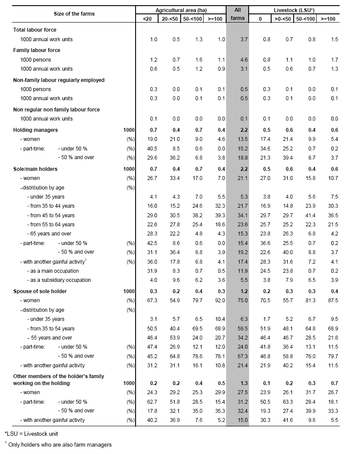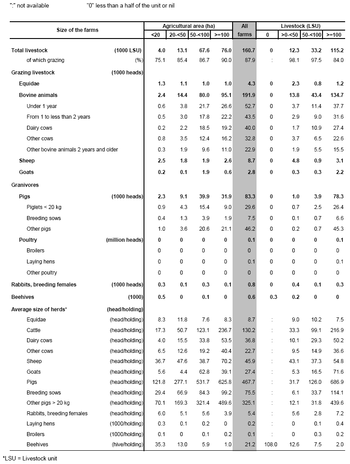- Data from May 2008, most recent data: Further Eurostat information, Main tables and Database.
This article is part of a series of country-specific essays on the results of the European Union (EU) Farm structure survey (FSS) 2007. It provides a brief but nevertheless comprehensive insight into farm structure in Poland.
The 2007 FSS recorded 2.4 million agricultural holdings in Poland, (3.5 % less than in 2005). This drop results mainly from a fall in the number of the smallest holdings which are not covered by the Single area payment system. The number of farms using less than 2 ha decreased from 84 000 in 2005 to 74 000 in 2007 (-12%).
Main statistical findings
52% of agricultural land and 56% of livestock in farms of less than 20 ha
In 2007, about 1.13 million agricultural holdings in Poland had an economic size of at least one European size unit (ESU), compared to 1.08 million in 2005.
These farms made use of 13.9 million hectares (ha) of utilised agricultural area, which makes the average size of a holding in Poland 12.3 ha (compared to 12.1 ha in 2005). See Figure 1 for the distribution of UAA in terms of farm size, while Table 2 describes the size distribution and other characteristics of the agricultural holdings.
These holdings employed 1.7 million annual work units (AWUs), the equivalent of 1.7 million people working full time. The organisation and distribution of the labour force in Poland is described in Figure 2 and Table 1.
The farms contained 10.7 million livestock units (LSU) in 2007, 6 % more than in 2005, mainly due to an increase in bovine animals. The distribution of livestock by farm size is shown in Table 4 and Figure 3.
Amongst the 1.13 million agricultural holdings in 2007:
- 29 % made use of less than one AWU, while another 29 % made use of two or more AWUs;
- 35 % used less than 5 ha, while 2 % used 50 ha or more;
- 20 % were producing mainly for own consumption;
- 38 % were holdings of the type mixed cropping;
- 36 % were engaged in mixed livestock; and
- 26 % were mixed farms.
Amongst the sole holders:
- 23 % were women in 2007 (compared to 22 % in 2005);
- 23 % were aged 55 or more and 17 % were younger than 35 years; and
- 32 % of family labour force had another gainful activity in 2007 (compared to 29% in 2005).
In Poland in 2007, 77 % of the agricultural area was owned by Farmers (more than 90 % in the holdings with less than 20 hectares).
The Family labour force regularly employed has increased, on the contrary to non family labour force.
145 240 ha were organically farmed (1 % of the utilised agricultural area, compared to 0.6 % in 2005). Details of land use by size of farm are given in Table 3.
More than 80 % of the dairy cows and 60 % of the pigs are kept in farms with less than 50 livestock units.
The situation for subsistence farming in Poland is outlined in Table 5.
Data sources and availability
Due to the different coverage of the FSS across Member States, the total number of farms is not comparable between countries. This is why the present analysis, including Tables 1-4 and the graphs focus on holdings of at least one European size unit.
The survey on the structure of agricultural holdings in Poland was carried out between 1 June and 9 July 2007 on a sample basis. Prior to this survey, a full-scale agricultural census was last conducted in 2002 and the sample farm structure survey in 2005. The reference day of the farm structure survey was the 1st June 2007 in the case of land area, land use, livestock, the characteristics defining the holder and manager and the number of tractors collected, to satisfy the national needs. For other characteristics the reference period was the 12 months preceding the reference day.
According to the national definition an agricultural holding has at least 0.1 ha total agricultural area; or has less than 0.1 ha of total agricultural area plus at least: 1 head of cattle and/or 5 heads of pigs or 1 sow and/or 3 heads of sheep or goats and/or 1 horse and/or 30 heads of poultry and/or 1 ostrich and/or 5 heads of female rabbits and/or 5 heads of other female fur animals and/or 3 heads of other animals kept for slaughter and/or 1 beehive.
On the basis of the Statistical Farm Register established after the 2002 census, a stratified sample was drawn. The holdings – including the newly established ones- have been divided into 8 groups according to their activity, size or legal form. The largest holdings, the units of legal entities as well as organic farms were observed without sampling. In the other groups different stratification criteria were used (e.g. total area, arable land, SGM) besides the geographic levels (NUTS2). Altogether, 29 strata were established in these groups, some of which were strata without sampling, while in the others Neymann and numerical optimisation methods of allocation were used to choose the units to be observed. The sample size was ca. 7% (i.e. 204,937 holdings were sampled out of a total population of 2,862,265 holdings).
The list of characteristics and their definitions were fully compliant with the EU requirements concerning the Farm Structure Survey 2007. However the areas of different categories of the permanent grassland are not fully comparable with the data from 2005 farm structure survey due to the introduction of a new characteristic on the permanent grassland eligible for financial support. Because of their minor economic significance in Poland compared to the 2005 farm structure survey the areas of hop, flax and hemp were included under other industrial plants; the area of sunflower crops was included under other oil seed crops and the area of permanent crops under glass was included under other permanent crops in 2007.
The data are checked at different levels Unit nonresponse has occurred due to refusals, lack of contact and liquidation of holdings. For these units, no imputation of data was carried out. Only in the case of some unanswered variables in the enumerated holdings, was an answer imputed which occurred more often in the population . The information from previous surveys and experts’ opinions were also used.
For each activity (`enterprise`) on a farm (for instance wheat, dairy cow or vineyard), a standard gross margin (SGM) is estimated, based on the area (or the number of heads) and a regional coefficient. The sum of such margins in a farm is its economic size, expressed in European Size Units (ESU, 1 ESU is a 1200-euro standard gross margin).
Each farm is classified in the community typology by its economic size and its type of farming, depending on the share of each enterprise in its economic size.
Annual working unit (AWU) means the labour force working yearly i.e. a worker employed on full time basis and working 2120 hours (265 working days of 8 working hours per day).
Context
European Commission Rural development policy aims to improve competitiveness in agriculture and forestry, improve the environment and countryside, improve the quality of life in rural areas and encourage the diversification of rural economies.
As agriculture has modernized and the importance of industry and services within the economy has increased, so agriculture has become much less important as a source of jobs. Consequently, increasing emphasis is placed on the role farmers can play in rural development, including forestry, biodiversity, the diversification of the rural economy to create alternative jobs and environmental protection in rural areas.
The FSS continues to adapt to provide timely and relevant data to help analyse and follow these developments.
Further Eurostat information
Publications
- Farm Structure Survey in Poland - 2007 - Statistics in focus 50/2008
- National Methodological Report – FSS 2007 Poland (available on request)
Main tables
- Agriculture, see:
- Structure of agricultural holdings (t_ef)
Database
- Agriculture, see:
- Structure of agricultural holdings (ef)
Dedicated section
- Agriculture, see:
- Ad-hoc tables: Farm Structure Survey








